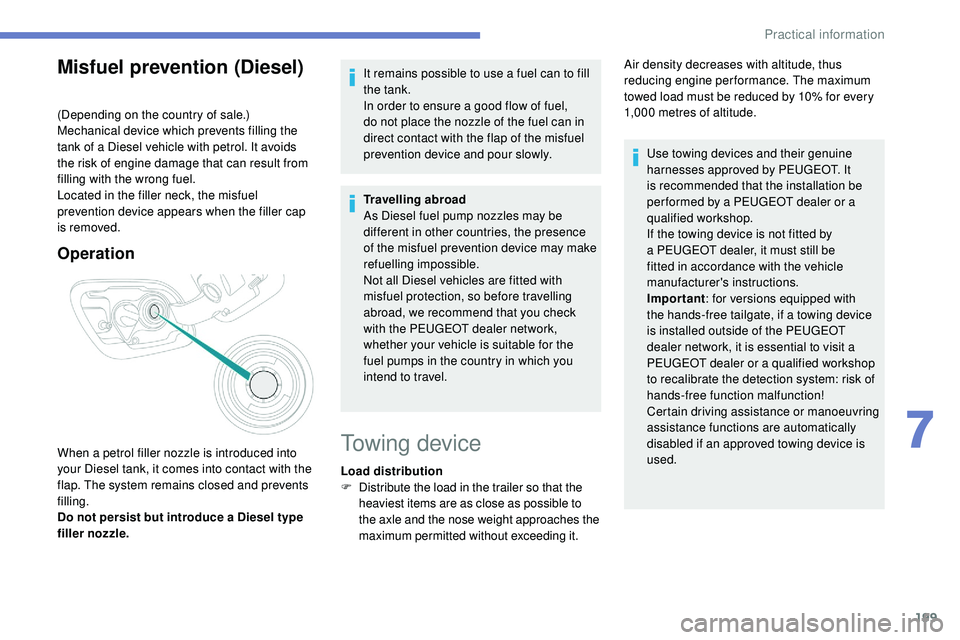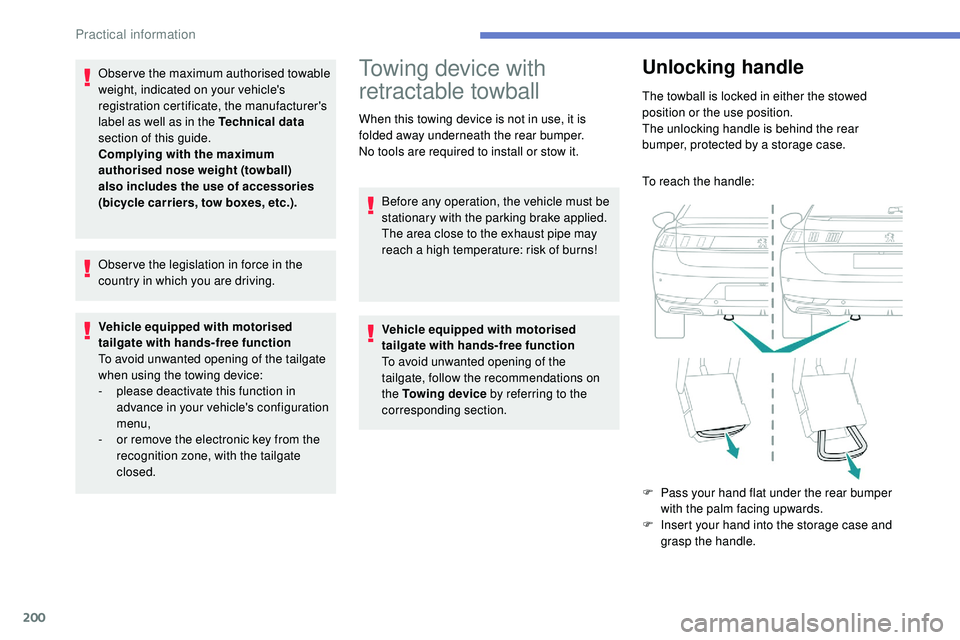Page 201 of 320

199
Misfuel prevention (Diesel)
(Depending on the country of sale.)
Mechanical device which prevents filling the
tank of a Diesel vehicle with petrol. It avoids
the risk of engine damage that can result from
filling with the wrong fuel.
Located in the filler neck, the misfuel
prevention device appears when the filler cap
is removed.
Operation
When a petrol filler nozzle is introduced into
your Diesel tank, it comes into contact with the
flap. The system remains closed and prevents
filling.
Do not persist but introduce a Diesel type
filler nozzle.It remains possible to use a fuel can to fill
the tank.
In order to ensure a good flow of fuel,
do not place the nozzle of the fuel can in
direct contact with the flap of the misfuel
prevention device and pour slowly.
Travelling abroad
As Diesel fuel pump nozzles may be
different in other countries, the presence
of the misfuel prevention device may make
refuelling impossible.
Not all Diesel vehicles are fitted with
misfuel protection, so before travelling
abroad, we recommend that you check
with the PEUGEOT dealer network,
whether your vehicle is suitable for the
fuel pumps in the country in which you
intend to travel.Towing device
Load distribution
F D
istribute the load in the trailer so that the
heaviest items are as close as possible to
the axle and the nose weight approaches the
maximum permitted without exceeding it. Use towing devices and their genuine
harnesses approved by PEUGEOT. It
is recommended that the installation be
per formed by a PEUGEOT dealer or a
qualified workshop.
If the towing device is not fitted by
a PEUGEOT dealer, it must still be
fitted in accordance with the vehicle
manufacturer's instructions.
Important
: for versions equipped with
the hands-free tailgate, if a towing device
is installed outside of the PEUGEOT
dealer network, it is essential to visit a
PEUGEOT dealer or a qualified workshop
to recalibrate the detection system: risk of
hands-free function malfunction!
Certain driving assistance or manoeuvring
assistance functions are automatically
disabled if an approved towing device is
used.
Air density decreases with altitude, thus
reducing engine performance. The maximum
towed load must be reduced by 10% for every
1,000 metres of altitude.
7
Practical information
Page 202 of 320

200
Obser ve the maximum authorised towable
weight, indicated on your vehicle's
registration certificate, the manufacturer's
label as well as in the Technical data
section of this guide.
Complying with the maximum
authorised nose weight (towball)
also includes the use of accessories
(bicycle carriers, tow boxes, etc.).
Obser ve the legislation in force in the
country in which you are driving.
Vehicle equipped with motorised
tailgate with hands-free function
To avoid unwanted opening of the tailgate
when using the towing device:
-
p
lease deactivate this function in
advance in your vehicle's configuration
menu,
-
o
r remove the electronic key from the
recognition zone, with the tailgate
closed.Towing device with
retractable towball
When this towing device is not in use, it is
folded away underneath the rear bumper.
No tools are required to install or stow it.
Before any operation, the vehicle must be
stationary with the parking brake applied.
The area close to the exhaust pipe may
reach a high temperature: risk of burns!
Vehicle equipped with motorised
tailgate with hands-free function
To avoid unwanted opening of the
tailgate, follow the recommendations on
the Towing device by referring to the
corresponding section.
Unlocking handle
The towball is locked in either the stowed
position or the use position.
The unlocking handle is behind the rear
bumper, protected by a storage case.
To reach the handle:
F
P
ass your hand flat under the rear bumper
with the palm facing upwards.
F
I
nsert your hand into the storage case and
grasp the handle.
Practical information
Page 239 of 320

237
Automatic gearbox: never tow the vehicle
with the front wheels on the ground with
the engine off.
F
U
nlock the steering and release the parking
brake.
F
S
witch on the hazard warning lamps on
both vehicles.
F
M
ove off gently and drive slowly over a
short distance only.
Towing another vehicle
F On the rear bumper, unclip the cover by pressing at the bottom.
F
P
ull the cover downwards.
F
S
crew the towing eye in fully.
F
I
nstall the towbar.
F
S
witch on the hazard warning lamps on
both vehicles.
F
M
ove off gently and drive slowly over a
short distance only. General recommendations
Obser ve the legislation in force in the
country where you are driving.
Ensure that the weight of the towing
vehicle is higher than that of the towed
vehicle.
The driver must remain at the wheel of
the towed vehicle and must have a valid
driving licence.
When towing a vehicle with all four wheels
on the ground, always use an approved
towbar; rope and straps are prohibited.
The towing vehicle must move off gently.
When the vehicle is towed with its engine
off, there is no longer braking and steering
assistance.
In the following cases, you must always
call on a professional recovery ser vice:
-
v
ehicle broken down on a motor way or
fast road,
-
f
our-wheel drive vehicle,
-
w
hen it is not possible to put the
gearbox into neutral, unlock the
steering, or release the parking brake,
- w hen it is not possible to tow a vehicle
with an automatic gearbox, engine
running,
-
t
owing with only two wheels on the
ground,
-
w
here there is no approved towbar,
etc. available.
8
In the event of a breakdown
Page 240 of 320

238
Engine technical data and
towed loads
Engines
The engine characteristics are given in the
vehicle's registration document, as well as in
sales brochures.The maximum power corresponds to the
value type-approved on a test bed, under
conditions defined in European legislation
(Directive 1999/99/EC).
For more information, contact a PEUGEOT
dealer or a qualified workshop.
Weights and towed loads
The weights and towed loads relating to your
vehicle are given in the registration document,
as well as in sales brochures.
These values are also given on the
manufacturer's plate or label.
For more information, contact a PEUGEOT
dealer or a qualified workshop. The GTW (Gross Train Weight) and towed load
values indicated are valid up to a maximum
altitude of 1,000 metres. The towed load value
must be reduced by 10% for each additional
1,000 metres of altitude.
The maximum authorised nose weight
corresponds to the weight permitted on the
towball.
High exterior temperatures may result
in a reduction in the per formance of the
vehicle to protect the engine. When the
exterior temperature is higher than 37°C,
limit the towed weight.
Towing by a lightly loaded vehicle can
adversely affect roadholding.
Braking distances are increased when
towing a trailer.
When using a vehicle to tow, never
exceed a speed of approximately 62 mph
(100 km/h) (obser ve the local legislation
in force).
If the exterior temperature is high, it is
recommended that the engine is allowed
to idle for 1 to 2 minutes after the vehicle
comes to a stop, to facilitate its cooling.
Technical data
Page 241 of 320
239
Engines and towed loads – Petrol
EnginesTHP 150 EAT6 THP 165 EAT6PureTech 180 S&S EAT8 PureTech 225 S&S EAT8
Gearboxes Automatic
6-speed Automatic
6-speed Automatic 8-speed
Automatic 8-speed
Codes KUM
(EP6FDTMD AT6III) KNM
(EP6FDTM AT6III) L L1
(EP6FADTXD ATN8 STT) L K1
(EP6FADTX ATN8 STT)
Model codes
Hatchback: FB...
SW: FE... 5GXV
5GY V 5GFR 5GGR
Body styles Hatchback Hatchback Hatchback SWHatchback SW
Cylinder capacity (cm³) 1,59 81,59 8 1,59 8 1,59 8
Max. power: EC standard (kW) 11 0121 13 3 165
Fuel Unleaded UnleadedUnleadedUnleaded
Braked trailer (within the GTW limit) (kg)
on a 10% or 12% gradient 600
6001,6 0 0 1,6 0 01,6 0 01,6 0 0
Unbraked trailer (kg) 600600 74 574 574 574 5
Maximum authorised nose weight (kg) 757575757575
9
Technical data
Page 242 of 320
240
Engines and towed loads – Diesel
EnginesBlueHDi 130 S&S BVM6BlueHDi 130 S&S EAT8
Gearboxes Manual 6-speedAutomatic 8-speed
Codes MAK
(DV5RC ML6C STT) M A1
(DV5RC ATN8 STT)
Model codes
Hatchback: FB...
SW: FE... YHZJ
YHZR
Body styles HatchbackSWHatchback SW
Cylinder capacity (cm³) 1,49 91,49 9
Max. power: EC standard (kW) 9696
Fuel DieselDiesel
Braked trailer (within the GTW limit) (kg)
on a 10% or 12% gradient 1,5 0 0
1,5 0 01,5 0 01,5 0 0
Unbraked trailer (kg) 74 574 574 574 5
Maximum authorised nose weight (kg) 75757575
Technical data
Page 243 of 320
241
Engines and towed loads – Diesel
EnginesBlueHDi 160 S&S EAT8 BlueHDi 180 S&S EAT8 HDi 180 EAT8
Gearboxes Automatic 8-speedAutomatic 8-speedAutomatic 8-speed
Codes PH1
(DW10FCC AMN8 STT) K A1
(DW10FC AMN8 STT) KA9
(DW10FC A MN8)
Model codes
Hatchback: FB...
SW: FE... EHYR
EHZREHZN
Body styles HatchbackSWHatchback SWHatchback SW
Cylinder capacity (cm³) 1,9 971,9 971,9 97
Max. power: EC standard (kW) 12013 3 13 3
Fuel DieselDieselDiesel
Braked trailer (within the GTW limit) (kg)
on a 10% or 12% gradient 1,8 0 0
1,8 0 01,8 0 01,8 0 0 600
1,8 0 0 * 600
1,8 0 0 *
Unbraked trailer (kg) 750750750750600
750* 600
750*
Maximum authorised nose weight (kg) 757575757575
*
O
nly for Russia.
9
Technical data
Page 245 of 320

243
Identification markings
Various visible markings for the identification
and research of your vehicle.
A. Vehicle Identification Number (VIN),
under the bonnet.
This number is engraved on the bodywork
structure.
B. Vehicle Identification Number (VIN),
on
the dashboard.
The number is on a label, visible through the
windscreen. C. Manufacturer's label.
This tamperproof label is affixed to the right-
hand door aperture.
It bears the following information:
-
t
he name of the manufacturer,
-
t
he European Whole Vehicle Type Approval
number,
-
t
he vehicle identification number (VIN),
-
t
he gross vehicle weight (GV W),
-
t
he gross train weight (GTW),
-
t
he maximum weight on the front axle,
-
t
he maximum weight on the rear axle.
D. Tyres/paint code label.
This label is affixed to the driver's door
aperture.
It bears the following information about the
tyres:
-
t
he tyre pressures, unladen and laden,
-
t
he tyre specification, made up of the
dimensions and type as well as the load
and
speed indices,
-
t
he spare tyre pressure.
It also indicates the paint colour code.
The vehicle may be originally equipped
with tyres with higher load and speed
indices than those indicated on the label,
without affecting inflation pressure.
9
Technical data